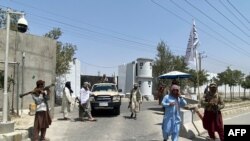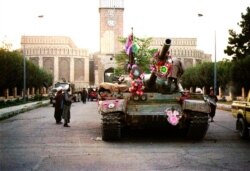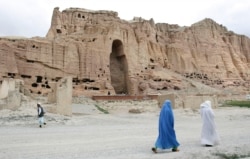It has been nearly 20 years since the Taliban last enforced their brutal version of Islamic law within the borders of Afghanistan. But the horrifying images of desperate Afghans trying to climb aboard a U.S. military aircraft taking off from Kabul’s airport Monday to escape the country demonstrate just how vividly some recall what life was like under the group.
During the relatively brief period during which the Taliban controlled most of Afghanistan, between 1996 and 2001, the group carried out multiple massacres of civilians, banned women from virtually all parts of public life, brutalized ethnic and religious minorities, and shattered what little remained of the economy in a country that had been at war for two decades.
In reclaiming control of Afghanistan, Taliban leaders have attempted to polish their image with claims of improved administrative skills and greater tolerance for women’s human rights. Yet the return of the Taliban is leading to fears that tens of millions of Afghans will be subjected to a reprise of the group’s violently repressive rule.
The Taliban’s origins
The Taliban emerged as the primary victor out of years of civil war in Afghanistan, a war which itself had followed a decade of insurgency against the occupying forces of the Soviet Union.
The group was originally made up of ethnic Pashtuns, loyal to the one-eyed cleric Mullah Omar, who founded the group in 1994 with significant assistance from the ISI, the intelligence arm of Pakistan’s military. The name “Taliban” derives from “talib,” or “student,” a name that was meant to evoke the group’s supposed adherence to Islamic law.
Early in its existence, the Taliban inspired a certain degree of loyalty from many Afghans, because in areas they controlled, they cracked down on corrupt local officials and criminals who had flourished during the disorder of the civil war.
The group eventually took control of about three-quarters of the country, but were unable to subjugate parts of the Northeast, which remained under the control of the so-called Northern Alliance.
Massacres and forced displacement
Throughout their time in control of most of the country, the Taliban continued to battle the Northern Alliance, slowly winning control of more territory. During that years-long campaign, the United Nations documented at least 15 massacres of civilians and captured fighters that the international body compared to the Bosnian genocide of 1992-1995.
The group also embarked on a series of massive forced relocations, emptying entire cities, razing buildings to the ground, and destroying agricultural infrastructure, leaving hundreds of thousands of people homeless and destitute.
In addition, the Taliban actively blocked delivery of emergency food supplies from international non-governmental organizations, leaving tens of thousands of people to face potential starvation.
Treatment of women
During their years in power, the Taliban were particularly known for their brutal treatment of women, applying an extremely harsh reading of Islamic moral codes. Women were banned from receiving an education, and were not allowed to hold jobs, except in very rare circumstances. Women were required to wear the burqa, a head-to-toe garment that completely covers the body, when appearing in public -- something they were allowed to do only while in the company of a male relative.
The rules were enforced by roving “morality police” who delivered on-the-spot beatings to women found in violation of Taliban rules. Other beatings, as well as executions, were conducted publicly.
The fate of many women who were not members of the Pashtun ethic group could be even worse. There are documented reports of thousands being abducted and sold into sex slavery within Afghanistan and in neighboring Pakistan.
Daily life
The Taliban’s strict interpretation of Islamic law extended into the daily life of most Afghans. The group banned television, kite-flying, soccer and virtually all kinds of music. Art, including photography, that depicted people was banned.
Cultural icons that the Taliban leadership deemed offensive to Islam were destroyed. The most widely known example of such “cultural genocide” was the destruction of the Bamiyan Buddhas, two giant statues of Gautama Buddha carved around 570 AD, which the Taliban blew up in 2001.
Government dysfunction
The Taliban, despite exercising military control over most of Afghanistan for five years, were never able to establish themselves as a competent government. Eventually, their inept administration of the country caused them to lose the support of many who had originally welcomed it.
In a study of the group’s rule, Said Yaqub Ibrahimi, of Carleton University in Ottawa, found that it “entirely failed in producing regular governance and a state system. It fell short in all aspects of stateness.”
The Taliban, he added, “lacked both internal and external legitimacy, had poor authority, and were incapable of producing basic services.”
Poor enforcement
In an article published by the Combating Terrorism Center at the United States Military Academy earlier this year, Thomas Ruttig, co-director and senior analyst of the Afghanistan Analysts Network, described the Taliban’s authority to enforce their diktats as limited.
“When the author visited Afghanistan as a journalist in late 1999, kids flew kites and Kabulis and Kandaharis played soccer,” he wrote. “The author observed locals dodging the Taliban’s religious police when they closed tea houses and restaurants during prayer time and tried to herd them into mosques. There was criticism against the restrictive anti-girls education policy, even among Taliban officials. Some tolerated or even protected home and NGO-run schools, warning those running them when hardliners planned to raid them.”
But poorly enacted repression is repression nonetheless, and no less real to those who are unable to escape it, as anyone at the Hamid Karzai International Airport in Kabul this week could plainly see.










